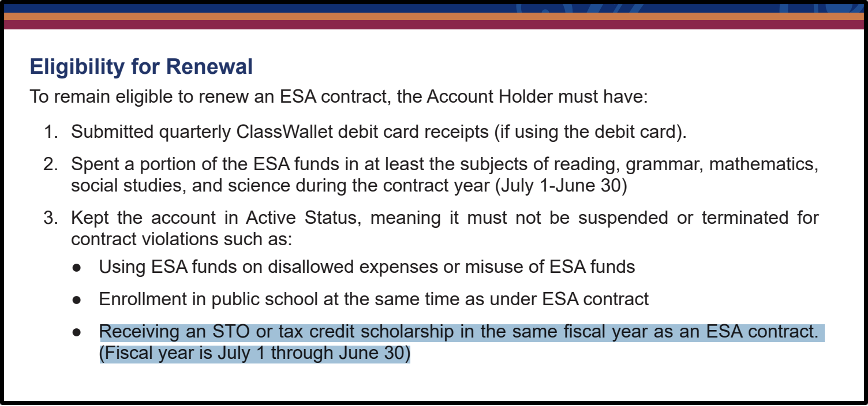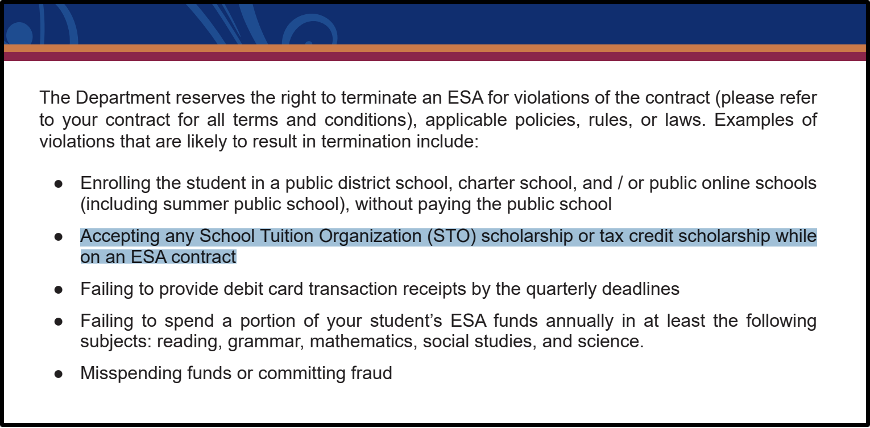“There are plenty of ways you can hurt a man
And bring him to the ground
You can beat him, you can cheat him
You can treat him bad and leave him when he’s down…”
Today’s mix-tape will focus on a recent, lesser-known change to the Arizona ESA program which has significantly impacted Arizona families: Prohibiting families from switching to the ESA program from a Tuition Tax Credit Scholarship (STO) in the same year, and vice versa.
Up until April 2023, the Arizona Department of Education (ADE), under multiple administrations over several years, has allowed families to receive STO funds and ESA funds in the same school year, but not at the same time. If you’re wondering how this worked or why it was needed, here is a typical scenario:
BEFORE
- A child receives an STO scholarship covering a few months of tuition.
- The child receives a diagnosis and goes through the public school district evaluation process, which is required for special education eligibility. This puts the child in an eligibility category that receives a higher ESA award – such as an autism diagnosis. This award is around $28k a year and can be used for tuition, therapies, tutoring, and curriculum.
- The child’s family decides to stop receiving STO funds and switches to an ESA in the next quarter.
- After the family notifies the private school and STO, the child now uses their ESA. This is a better fit for the family, who now has the funding their special needs child deserves, for the disability category they rightly qualify for.
NOW
The current ESA handbook, approved in April 2023, now prohibits families from using an ESA and an STO in the same school year – not just at the same time (Arizona statute already prohibits this, A.R.S. 15-2402(B)(3)). This change in the handbook and policy interpretation means that families receiving a special education diagnosis can no longer switch from an STO to an ESA in the same year, and vice versa.
In May 2023, ADE somewhat updated its policy on this issue but without updating the approved handbook. The updated policy is not really a solution though. How will it work now? There hasn’t been much printed guidance on the process, but from what we know:
- A child is receiving a tuition tax credit scholarship from an STO for tuition.
- The child receives a qualifying diagnosis and the family decides to switch to an ESA.
- They can switch to an ESA (which the handbook doesn’t say); however, they must pay back out-of-pocket all the tuition to the private school themselves, and the school must refund the entire tax-credit scholarship to the STO before receiving the ESA.
The above example shows just how confusing and difficult this change will be for parents. I doubt this is a viable option for many families.
In addition, the language in the current ESA handbook is unclear on this issue as seen below:
ESA Handbook 2023-24 – Page 53

There is no mention of the later, verbal comments that said families could switch as long as they personally paid back all the tuition to the private school. Here’s a scenario showing the significant impact this change in administrative procedure could have on special needs children:
Let’s say you’re a parent who has had an STO cover 5 months of your child’s tuition at $1,000 a month but you now want to switch to an ESA the next quarter because of a new diagnosis. The new diagnosis means your child qualifies for a higher ESA eligibility category, but in order to switch, you have to pay $5,000 of tuition to the school, out-of-pocket. Switching to the ESA doesn’t help much because you can’t use the scholarship to pay tuition from earlier in the year because your child wasn’t on ESA then.
This change in long-standing policy is obviously most detrimental to children receiving a diagnosis because it prevents them from receiving the higher ESA funding they qualify for. With 1-in-36 children diagnosed with autism impacting their education every year, you can see the challenge this change creates.
“And another one gone, and another one gone
Another one bites the dust”
Considerations:
- When ESA implementing agencies consider changing long-standing policies or administrative procedures, they should involve all potential stakeholders in the process such as ESA parents, private schools, public schools, School Tuition Organizations, policy leaders, etc.
- Changes in policy or administrative procedures that are not part of a rule making process should nevertheless receive adequate notice and public feedback, especially from families most likely to be impacted. Although not required by law, this approach will foster transparency and hopefully avoid the dreaded “unintended consequences.”
- ESA implementing agencies should ensure language in official and unofficial communications, especially with ESA families, regarding policies and procedures are consistent and clear.
“But I’m ready, yes, I’m ready for you
I’m standing on my own two feet
Out of the doorway the bullets rip
Repeating the sound of the beat….”
Certain families who get a diagnosis and want to switch to ESA will likely be “knocked down” by this change in policy every year. But if there’s one thing I’ve learned about special needs families, they’ll be standing on their own two feet through the ups and downs of the ESA program long after this.
Warmly,









